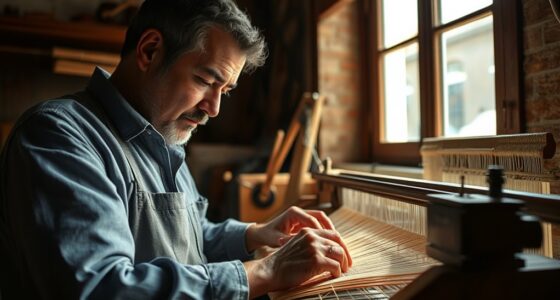The Palio di Siena is an ancient horse race that showcases fierce rivalries among Siena’s districts, called contrade. Each contrada has its own colors, symbols, and traditions, forming a strong community identity. This event reflects Siena’s history of independence and resilience, bringing residents together through elaborate rituals, costumes, and festivities. The race isn’t just about competition; it’s a vibrant celebration of local heritage. If you explore further, you’ll discover the deep cultural significance behind these spirited traditions.
Key Takeaways
- The Palio di Siena originated in the 16th century as a rivalry among Siena’s contrade, symbolizing local unity and independence.
- It has evolved into a highly organized event featuring costumes, banners, and rituals that preserve medieval traditions.
- Each contrada’s unique emblem and customs foster strong community pride and reinforce local identity.
- The race involves active community participation through festivals, preparations, and celebrations that strengthen social bonds.
- The event connects Siena’s rich history with present-day festivities, celebrating cultural heritage and collective resilience.

Have you ever wondered what makes the Palio di Siena one of Italy’s most electrifying and historic events? It all begins with its rich historical origins, dating back to the medieval period. The Palio originated in the 16th century as a way for the different contrade, or districts, of Siena to showcase their rivalry and community pride through a spirited horse race. These districts, each with its own distinct identity, have been competing for centuries, and the race quickly became a symbol of local unity and rivalry. Over time, the event evolved from informal competitions into a highly organized tradition, complete with elaborate costumes, banners, and rituals that have been preserved for generations. The historical roots of the Palio are deeply intertwined with Siena’s political and social history, reflecting the city’s independence, resilience, and communal spirit. Additionally, the event’s community involvement plays a vital role in maintaining its authenticity and vibrancy.
The cultural significance of the Palio di Siena extends far beyond the race itself. It’s a vivid expression of Siena’s identity, a celebration of its history, and a monument to the enduring bonds among its residents. Each contrada has its own emblem, colors, and customs, which are proudly displayed during the event. These districts foster a sense of belonging and pride, and the Palio serves as a yearly reminder of the city’s collective heritage. The race is more than just a competition; it’s a cultural ritual that involves the entire community. From preparing the horses and riders months in advance to organizing festas and celebrations leading up to the event, every aspect reinforces a sense of tradition and shared purpose. Locals and visitors alike participate in these festivities, emphasizing the event’s role in strengthening community ties.
The Palio’s cultural significance also lies in its ability to preserve ancient customs and stories. The event features historical costumes, religious processions, and a traditional blessing of the horses that date back centuries. These rituals connect the present with Siena’s past, ensuring that the city’s history remains alive through vibrant, communal participation. For many residents, the Palio is more than a race; it’s a celebration of Siena’s enduring spirit, its history of independence, and its passionate community life. The event’s enduring appeal lies in this blend of history, culture, and community pride, making the Palio di Siena a truly unique and mesmerizing experience for everyone involved.
Frequently Asked Questions
How Are the Horses Selected for Each Race?
You might wonder how horses are chosen for each race. The horse selection process for race participation involves a committee that carefully evaluates each horse’s speed, stamina, and temperament. Only those that meet strict criteria are allowed to compete, ensuring fairness and safety. Owners often enter their best horses, and the selection aims to create a competitive and exciting race, reflecting the tradition and community spirit of the Palio di Siena.
What Are the Origins of the Palio Di Siena?
You discover that the Palio di Siena’s roots run deep in medieval origins, rooted in civic pride and local loyalties. This historic horserace began as a simple, spirited contest to celebrate Siena’s independence and unity. Over centuries, it evolved into a spectacular spectacle that symbolizes community identity, rivalry, and tradition. The Palio’s origins highlight Siena’s enduring devotion to its history, heritage, and the heart of its communal harmony.
How Do the Competing Contrade Prepare for the Event?
You actively participate in contrade rituals and training preparations to get ready for the Palio. You practice daily, honing your riding skills and understanding the race’s traditions. You also engage in symbolic ceremonies, strengthening your community bonds. These preparations foster team spirit, guarantee readiness, and uphold the rich heritage of Siena’s contrade, making every step of the process a crucial part of the thrilling event you’re about to experience.
What Role Do the Historical Costumes Play in the Race?
The historical costumes play a essential role in the race by embodying costume symbolism and historical authenticity. As a participant or spectator, you see how each contrada’s attire reflects its unique identity and history. These costumes, with their vibrant colors and intricate designs, honor Siena’s past and add a sense of grandeur and tradition to the event. They serve to deepen the connection between modern participants and their rich heritage.
How Has Modern Tourism Impacted the Palio’s Traditions?
Have you noticed how modern tourism has transformed the Palio? It’s led to increased tourist commercialization, which can overshadow the event’s authentic cultural preservation. While visitors bring excitement and revenue, they also risk diluting the traditions that define the race. Do you think this balance can be maintained? You can help by respecting the customs and supporting efforts that prioritize the event’s cultural integrity over mere spectacle.
Conclusion
As you experience the Palio di Siena, you become part of a vibrant tapestry of tradition, rivalry, and community pride. Imagine standing in the Piazza del Campo, feeling the roar of the crowd as the horses race past—just like in 2000 when the city’s passion united residents. This event isn’t just a race; it’s a living symbol of Siena’s spirit, reminding you that beneath the competition lies a deep sense of belonging that keeps the city alive.









